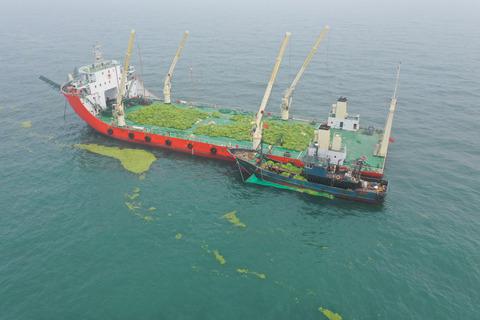当前位置:
X-MOL 学术
›
J. Appl. Ecol.
›
论文详情
Our official English website, www.x-mol.net, welcomes your feedback! (Note: you will need to create a separate account there.)
Macroalgal blooms caused by marine nutrient changes resulting from human activities
Journal of Applied Ecology ( IF 5.7 ) Pub Date : 2020-03-04 , DOI: 10.1111/1365-2664.13587 Hui Wang 1, 2 , Guangce Wang 1, 2 , Wenhui Gu 1, 2
中文翻译:

人类活动导致海洋营养变化导致的大型藻华
更新日期:2020-03-04
Journal of Applied Ecology ( IF 5.7 ) Pub Date : 2020-03-04 , DOI: 10.1111/1365-2664.13587 Hui Wang 1, 2 , Guangce Wang 1, 2 , Wenhui Gu 1, 2
Affiliation

|
- Macroalgal blooms (green tides) are occurring more frequently in many regions of the world, leading to significant impacts on marine ecology and economies. Although many studies and hypotheses have been proposed, the exact mechanism of green tide formation remains unclear.
- The world's largest green tides recur in the Yellow Sea and this area is representative for studying the origin and mechanism of green tide formation. We conducted a meta‐analysis of studies related to green tides and associated hypotheses for their formation.
- Rapid industrialization/urbanization and environmental protection actions in coastal zones have led to an increase in nitrate (nitrite) and decline in ammonium (ammonia), and this has resulted in increasing levels of dissolved inorganic nitrogen in seawater.
- We found that presence of appropriate attachment substrates for Ulva including laver culture rafts and certain hydrological conditions are supplementary factors to green tide formation in the Yellow Sea.
- Changes in marine nutrient levels promote the production of nitric oxide, which is essential for Ulva sporulation. Consequently, numerous spores are created and attach to substrates including laver culture rafts and parent Ulva thalli. These spores then develop into new thalli that are capable of producing further spores. As a result, Ulva thalli rapidly occupy vast areas of the sea and develop into green tides.
- Synthesis and applications. Our synthesis identifies that escalating marine nitric oxide generation caused by various factors and its essential role in Ulva sporulation are underlying and significant components in the mechanism of green tide formation. We provide solutions such as the improvement of comprehensive management of aquaculture and strict restriction of marine nitrate pollution, to prevent green tides. Furthermore, we propose an innovative wastewater treatment programme combined with Ulva application to fulfil the standard of sustainable development and circular economy.
中文翻译:

人类活动导致海洋营养变化导致的大型藻华
- 在世界许多地区,大型藻类(绿色潮汐)泛滥的发生,对海洋生态和经济产生了重大影响。尽管已经提出了许多研究和假设,但尚不清楚绿潮形成的确切机制。
- 世界上最大的绿潮出现在黄海,该地区是研究绿潮形成的起源和机理的代表。我们对与绿潮及其形成相关假设有关的研究进行了荟萃分析。
- 沿海地区迅速的工业化/城市化和环境保护行动导致硝酸盐(亚硝酸盐)增加和铵盐(氨)减少,这导致海水中溶解的无机氮含量增加。
- 我们发现合适的附着基片是存在于石莼包括紫菜文化筏和某些水文条件的补充因素在黄海绿潮的形成。
- 海洋营养物含量的变化会促进一氧化氮的产生,这对于Ulva孢子形成至关重要。因此,产生了许多孢子并附着在包括紫菜培养筏和亲本Ulva thalli的基质上。这些孢子然后发展成为能够产生更多孢子的新的塔利。结果,Ulva thalli迅速占领了大海的广阔区域,并发展为绿色潮汐。
- 综合与应用。我们的综合研究表明,由各种因素引起的海洋一氧化氮生成水平上升及其在Ulva孢子形成中的重要作用是绿潮形成机理的基础和重要组成部分。我们提供诸如改善水产养殖综合管理和严格限制海洋硝酸盐污染等解决方案,以防止绿潮。此外,我们提出了一种创新的废水处理方案,结合Ulva的应用,以达到可持续发展和循环经济的标准。



























 京公网安备 11010802027423号
京公网安备 11010802027423号